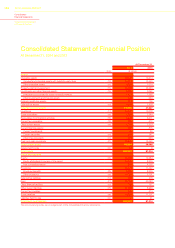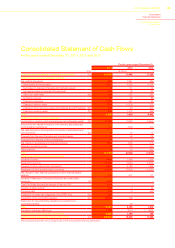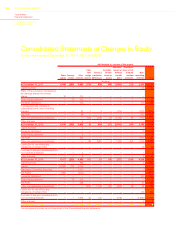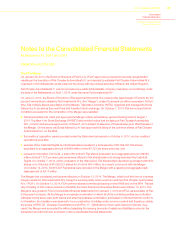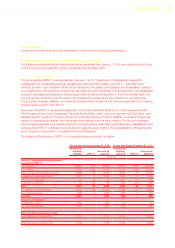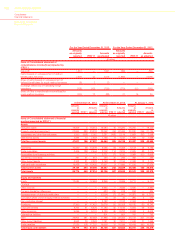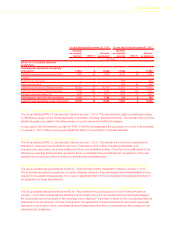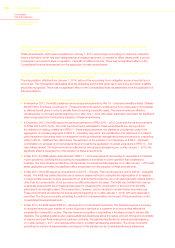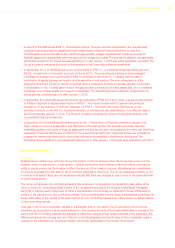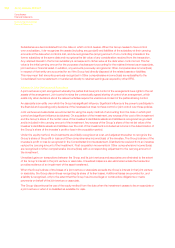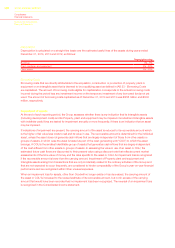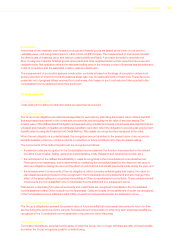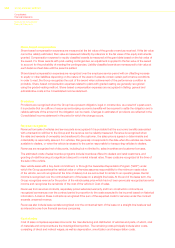Chrysler 2014 Annual Report Download - page 155
Download and view the complete annual report
Please find page 155 of the 2014 Chrysler annual report below. You can navigate through the pages in the report by either clicking on the pages listed below, or by using the keyword search tool below to find specific information within the annual report.
2014 | ANNUAL REPORT 153
In July 2014 the IASB issued IFRS 9 – Financial Instruments. The improvements introduced by the new standard
includes a logical approach for classification and measurement of financial instruments driven by cash flow
characteristics and the business model in which an asset is held, a single “expected loss” impairment model for
financial assets and a substantially reformed approach for hedge accounting. The standard is effective, retrospectively
with limited exceptions, for annual periods beginning on or after January 1, 2018 with earlier application permitted. The
Group is currently evaluating the impact of this standard on its Consolidated financial statements.
In September 2014, the IASB issued narrow amendments to IFRS 10 – Consolidated Financial Statements and
IAS 28 – Investments in Associates and Joint Ventures (2011). The amendments address an acknowledged
inconsistency between the requirements in IFRS 10 and those in IAS 28 (2011), in dealing with the sale or
contribution of assets between an investor and its associate or joint venture. The main consequence of the
amendments is that a full gain or loss is recognized when a transaction involves a business (whether it is housed
in a subsidiary or not). A partial gain or loss is recognized when a transaction involves assets that do not constitute
a business, even if these assets are housed in a subsidiary. The amendments will be effective, prospectively, for
annual periods commencing on or after January 1, 2016.
In September 2014 the IASB issued the Annual Improvements to IFRSs 2012-2014 cycle, a series of amendments
to IFRSs in response to issues raised mainly on IFRS 5 – Non-current assets held for sale and discontinued
operations, on the changes of method of disposal, on IFRS 7 – Financial Instruments: Disclosures on the
servicing contracts, on the IAS 19 – Employee Benefits, on the discount rate determination. The effective date of
the amendments is January 1, 2016. The Group is currently evaluating the impact of these amendments on its
Consolidated financial statements.
In December 2014 the IASB issued amendments to IAS 1- Presentation of Financial Statements as part of its
major initiative to improve presentation and disclosure in financial reports. The amendments make clear that
materiality applies to the whole of financial statements and that the inclusion of immaterial information can inhibit the
usefulness of financial disclosures. Furthermore, the amendments clarify that companies should use professional
judgment in determining where and in what order information is presented in the financial disclosures. The
amendments are effective for annual periods beginning on or after January 1, 2016 with early application permitted.
Basis of Consolidation
Subsidiaries
Subsidiaries are entities over which the Group has control. Control is achieved when the Group has power over the
investee, when it is exposed to, or has rights to, variable returns from its involvement with the investee, and has the
ability to use its power over the investee to affect the amount of the investor’s returns. Subsidiaries are consolidated
on a line by line basis from the date on which control is achieved by the Group. The Group reassesses whether or not
it controls an investee if facts and circumstances indicate that there are changes to one or more of the three elements
of control listed above.
The Group recognizes a non-controlling interest in the acquiree on a transaction-by-transaction basis, either at fair
value or at the non-controlling interest’s share of the recognized amounts of the acquiree’s identifiable net assets.
Net profit or loss and each component of Other comprehensive income/(loss) are attributed to Equity attributable to
owners of the parent and to Non-controlling interest. Total comprehensive income /(loss) of subsidiaries is attributed to
Equity attributable to the owners of the parent and to the non-controlling interest even if this results in a deficit balance
in Non-controlling interest.
Changes in the Group’s ownership interests in a subsidiary that do not result in the Group losing control over the
subsidiary are accounted for as an equity transaction. The carrying amounts of the Equity attributable to owners of the
parent and Non-controlling interests are adjusted to reflect the changes in their relative interests in the subsidiary. Any
difference between the carrying amount of the non-controlling interests and the fair value of the consideration paid or
received in the transaction is recognized directly in the Equity attributable to the owners of the parent.



